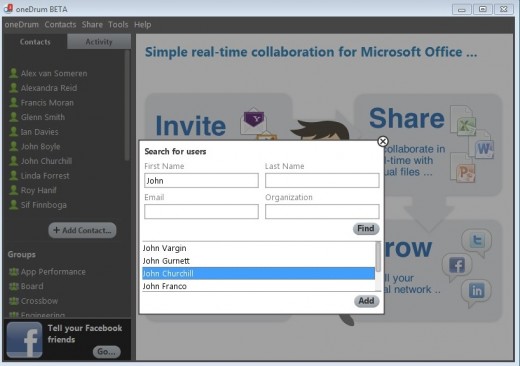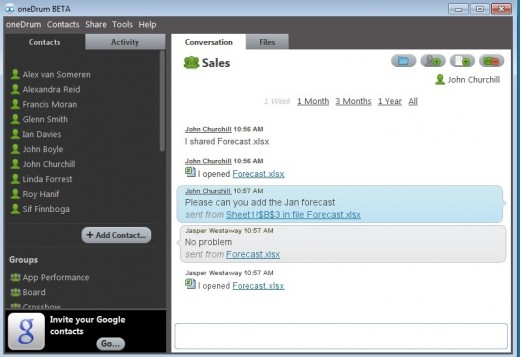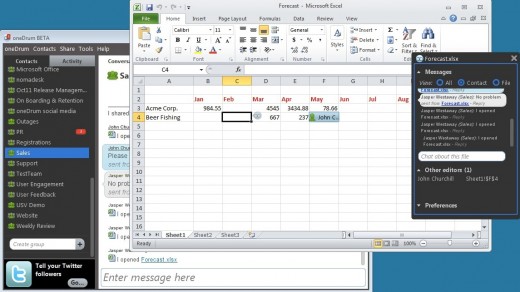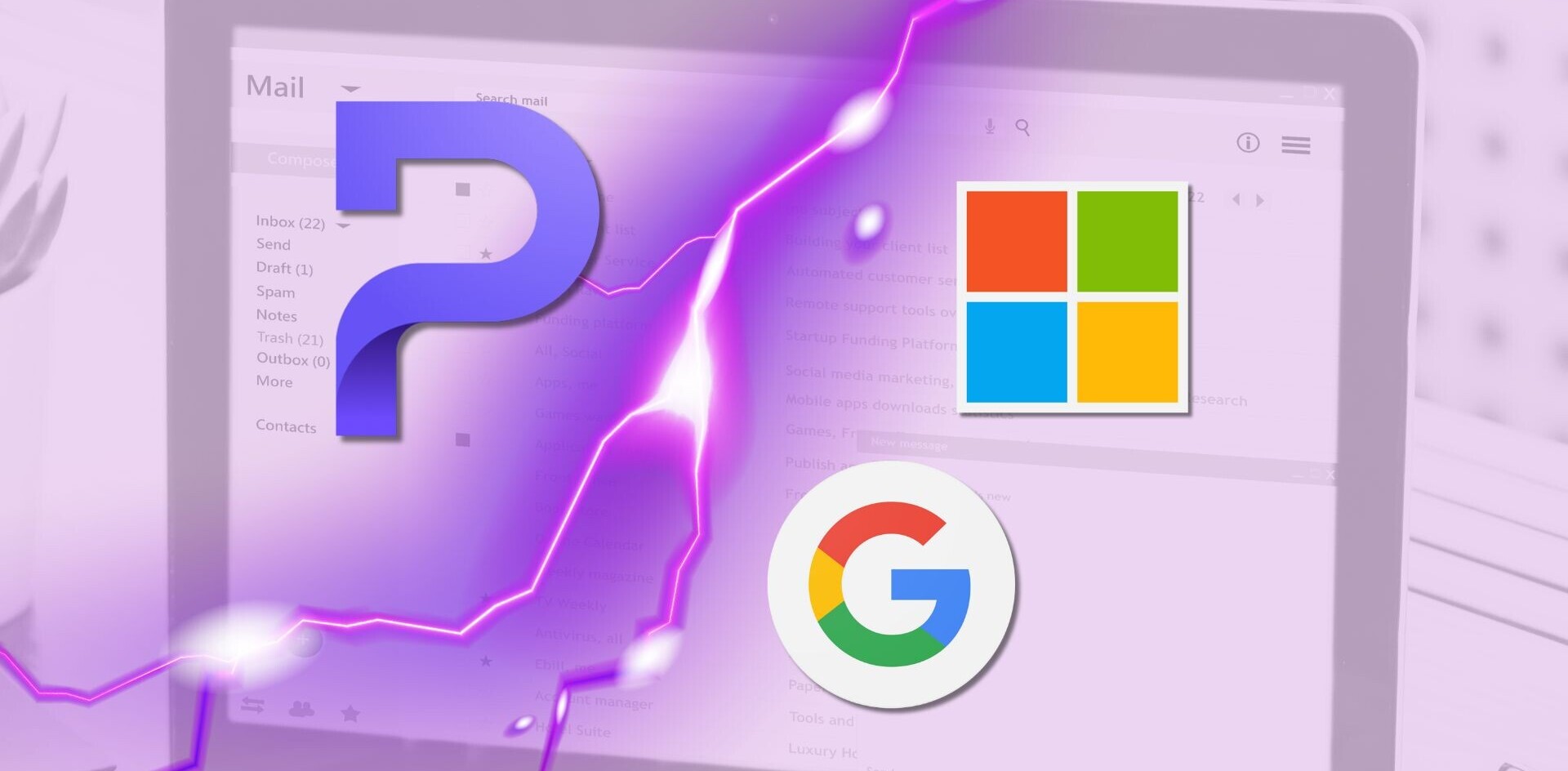
With all the bluster about cloud computing and Web-based collaborative working in recent times, you could be forgiven for thinking that desktop based applications such as Microsoft Office were soon to be consigned to the history books. But one startup clearly thinks otherwise.
oneDrum is a Scotland-based startup which has cropped up a number of times on The Next Web recently, entering public beta at The Next Web Conference earlier this year, where we interviewed CEO and founder Jasper Westaway. Here he is explaining a little bit about what oneDrum does:
The company also got name-checked in our Startup Scotland feature a couple of months back, so there’s definitely something about this startup that we can’t shake off. Here’s a quick look at exactly what oneDrum is all about.
What is oneDrum?
OneDrum is a P2P desktop application, and it sells itself as the only application that allows users to securely co-author, file-share and interact in real-time on Microsoft Office applications, covering Word, Excel and PowerPoint. It effectively brings Google Docs functionality and more to Microsoft Office documents, with edits appearing in real-time when working online, and offline edits synchronizing seamlessly when connectivity is re-established.
But wait a minute, what about Microsoft’s very own cloud-based Office Web Apps, or Office 365 which was launched earlier this year? There’s a clear push away from the desktop, so where does oneDrum fit into things?
“We’re different in a number of ways”, says Jasper. “But crudely, Microsoft doesn’t offer any real-time sharing capability in desktop MS Office, only in its browser-based version – and then only in a limited way. We take any version of MS Office on Windows and make it real-time. I can see where you are working inside my copy, I can see your changes as you are typing, adding shapes etc… not just when you hit save and I get a notification. This is what happens in Office 2010, in the enterprise edition that mixes SharePoint.”
Jasper tells me that they currently have a number of Microsoft Office resellers approaching them, because their users are asking for the Google Docs experience. So why not just use Google Docs? Well, in an interview with The Next Web’s Hermione Way back in March, Jasper explained: “If you want to produce high-class, professional documents, you don’t use Google Apps, you use Microsoft Office”, he said. “Just like the Google Apps team themselves!”
Jasper says that they’re trying to be a consumer experience, which means no servers or admins, and they’ve implemented a very simple set-up.
So, if you’re addicted to the Microsoft Office desktop version, you need its rich functionality, but also want Google Docs style shared-working, oneDrum could be for you. “oneDrum takes the compromise out of collaboration, and it is the only application that enables users to have shared documents on-hand, and up-to-date, at every moment”, says Jasper. For the record, this all takes place using a “simple and complete security model” that combines user authentication, network security and data encryption to ensure that all aspects of the collaboration process are secure.
“Our goal has always been to reset how people understood both what a networked application is, and how it should be built,” said Jasper. “We designed oneDrum to be insanely powerful and with as few compromises as possible. Users want files to be accessible and editable offline, and co-authoring, file sharing and chat messaging are all experiences that people have become accustomed to and need for productivity.”
Using oneDrum
oneDrum is written in Java, which allows the application to support multiple operating systems. It supports 2003, 2007 and 2010 versions of Microsoft Office for Windows, and whilst it does currently work on Mac, “the cool stuff only works on Windows” at present. The full Mac version is being launched later this year.
Jasper says that the next phase of the cloud will need to adopt a hybrid model that straddles data centers, user devices and applications more effectively, something he believes oneDrum offers.
Future plans include the development of an application programming interface (API) and software development kit (SDK) to allow users to customize any application they are developing or upgrading to enable it to become collaborative. And this is a key point to note, although the big focus just now is on Microsoft Office, the underlying technology is applicable to anything.
In terms of pricing, oneDrum is free to download and use, and it’s their intention to always offer an entry-level version of oneDrum for no charge. In February 2012, a premium, subscription-based version will be released providing a variety of extra features such as backup to the cloud and Web access to files.
oneDrum is underpinned by vector transformation technology, and it’s this mechanism that ensures when multiple people are changing data, everyone has access to and can edit that data. So for the Microsoft Office generation, could we soon be seeing endless streams of email attachments come to an end, given that the latest version of a document is always accessible to all collaborators?
“In general, email looks like it helps collaboration, because it helps people communicate and pass files around,” said Jasper. “In fact, it’s a huge problem. Email results in proliferating legacy copies of files and users are generally operating outside of any kind of structured workflow. Receiving five versions of a document and having to merge, edit, assess and audit everyone’s input is classic document collaboration hell.”
Working with oneDrum
The installation process is straight-forward – you simply sign-up and instal it on your machine. When you first load it, you can invite your contacts from across a myriad of channels to join you. Typically, these would likely be your work colleagues and you can manually enter email addresses, but you can find contacts to connect with directly from LinkedIn, Outlook, Gmail, Yahoo, Twitter and Facebook.
Until you have a least one contact in there, things do seem rather barren and, indeed, oneDrum is all about collaborative working so you can test it out for yourself by inviting work colleagues to join you.
Depending on what you want to do, there are 4 screens – Contacts, Activity, Conversation and Files. The conversation screen shows you who you’ve recently chatted to from your contacts, plus references to any files that have been worked on:
The Files screen summarizes the history of all file-sharing activity:

Sharing files is pretty striaght forward, you can click the little ‘plus’ icon on a contact’s profile, and then select the file you want to share from your desktop:
Once a document is shared, and thus made collaborative, it’s easy to see who else has access, and who is editing which cells on a spreadsheet:
Each person has the file stored in folders on their machine in a /oneDrum folder on the C:Drive, but they’re not standard folders. “We instal the files on your C:Drive in an encrypted database”, says Jasper. “oneDrum creates a virtual representation of the file system using technology called fuse”. This is how oneDrum links versions of Microsoft Office documents across machines, and it’s also worth noting that if you were to kill oneDrum on your computer, the shared files would disappear from the documents folder.
To get a better idea of how you can use oneDrum to collaborate on Excel files, check out the demo video here:
oneDrum is good to go now with Excel and PowerPoint files, but I’m told that they’re still fine-tuning some key elements in Word, such as the real-time collaborative editing and in-document chat feature – though that won’t stop you using it in its current incarnation. As such, oneDrum will be keeping its beta tag for the time-being, but its full launch is imminent.
The verdict
As someone who was practically married to Microsoft Office for the best part of ten years, I can definitely see the appeal that oneDrum will have with many users – it will help you avoid the messy nature of emailing documents with tracked changes.
Whilst I pretty much use Google Docs now for the most part, anyone that’s still tied to Office out of necessity should certainly check oneDrum out.
Get the TNW newsletter
Get the most important tech news in your inbox each week.









